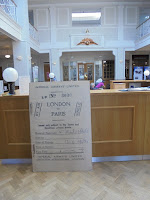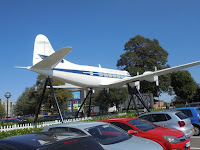Airport
House, Purley Way,
Croydon, CR0
0XZ
Sunday
September 2 2018
This is a
Museum, run almost entirely by volunteers, which only opens once a month hence
our Sunday visit. Linda’s photos were taken by plane enthusiast Roger and we
were also joined by Mary J, who has lived in nearby Sutton for all of her life.
The Museum offers both free flow and guided visits and we
opted for the latter – our guide had clearly been a plane lover since child
hood and spoke with undiminished zest of early air travel in general and this
airport in particular.
There are three interlocking strands to this visit: the
historic and very decorative buildings, the history of the airfield and the
evolution of British Imperial Airways which is closely tied to that of the
airfield.
The buildings you see today were completed in 1928 and as such
were designed to offer the intrepid traveller an experience somewhere between
the luxury values of travelling by liner, and the convenience of going by
train. We were told that it was the first PURPOSE BUILT civil airport in the
world, pioneer of such now-standard features as the separation of arrivals and
departures and of freight and passengers, not to mention a succession of
purpose-built control towers. The date of completion reflects the favoured
style of the times – ART DECO – though like much of that inter-war construction
the materials are not all that they might seem. It is essentially a brick
building covered in some kind of composite painted white – not even Coade stone
as you might expect. The third storeys were added in later years. At its
busiest the airport had several hangars and outbuildings, now demolished. The
very presence and success of the airport also generated related industries for
Croydon that supported or were part of air travel – this in turn encouraged
employment and an expansion in nearby housing – all in an area that was once
fields…
I may sound a little dismissive of the building but in fact
in late summer sunshine it looked lovely with just enough embellishment to give
it a ‘modern but classic’ air. Once inside the Thirties style continues with
wooden panelling and a welcoming reception desk. Unlike today’s airports where
the emphasis is on encouraging you to
spend money by reducing seating capacity this , the world’s first purpose built
airport lounge offered congenial seating and just one kiosk – a prototype WH
Smith’s selling what is had always sold. The original wooden banquettes have been
replaced by leather look sofas.
To understand exactly why it is here we were reminded that during the First World War
the Germans were sending over Zeppelins, which could fly at great altitude for
up to 20 hours non-stop, enabling them to drop bombs on English targets, though
their navigation was not always precise. When bombs from one wandering Zeppelin
killed civilians in London, public and Parliament demanded visible
countermeasures and the Royal Flying Corps established a presence at Croydon
(largely ‘window dressing’ as it took time to develop effective anti-Zeppelin
measures). Subsequently, it was recognised that as the threat came from the
east Croydon was not the best centre to combat it and the airfield then became
a base for training RFC pilots who departed for the front after very few flying
lessons, many never to return. There was also an aircraft factory.
Come the end of the conflict, airplanes, and the pilots who
survived weren’t going anywhere so the airfield started hosting novelty flights
then as peace and commerce re-established themselves civil aviation took off in
all senses. While the fields remained –
at that point aircraft took off and landed into the wind on grass – the
building went up.
The Reception area and the stairs are adorned with
photographs of the airport at its busiest and most famous. One of the most
celebrated pilots was Amy Johnson who flew solo starting from here to
Australia. Less well known is that she
attempted to fly West across the Atlantic (previous crossings had all made the
passage West to East because of the prevailing winds, and even today the time difference crossing the Atlantic is
significant). There is a telling photo of a failed take off with her
short-lived husband looking less than pleased with the resulting plane damage –
he was short lived as a husband that is, it having been a case of marry in
haste and repent at n leisure...
Another interesting photo shows the line-up of overseas planes with their national insignia including Lufthansa’s swastika tail symbol sitting
happily next to a Dutch plane – not so two years later.
From something like 2,000 passengers in the first year of
operation numbers rose to over 120,000 by the mid-1930s but transporting mail
remained for a long time the most lucrative part of the business. Also the
number of passengers could be eclipsed by the number of sight-seers – over 100,000
turned up at the airport to welcome the return of Amy Johnson.
One piece of aviation history that Croydon can NOT claim is
the famous ‘Munich’ photo of Neville Chamberlain emerging from an aircraft in
1938 holding aloft his famous piece of paper: that flight landed at Heston
airfield. Heston appears as well as
Croydon in ‘The History of Aviation’, a large mural by William Kempster
commissioned for Heathrow and unveiled by the Queen in 1969, which is on loan
to Croydon till the end of the year.
Interspersed between the large size photos are a variety of
historic advertising and promotional posters offering everything from tea in
the air on a jaunt down to Brighton or ‘weekly trips to India & Australia’
– the latter taking three weeks, with multiple overnight stops. These were all
the proud boasts of Imperial Airways whose home turf this surely was. Early
aircraft were barely-converted bombers left over from the War, and even later
purpose-designed biplanes retained features such as open cockpits for the
pilots even if passengers travelled in comfortable (?) cabins. Advertisements
pointed out that aircraft with 4 engines were naturally safer than those with
only two.
As we admired the control tower from the outside m our guide
explained how primitive early aircraft
control was… From the pilots’ points of view their navigation was determined
but what they could see and hopefully recognise from the air – prime landmarks
being the coast, the River Thames (you’ve gone too far) and the railway. A favourite route from
Europe was to find Brighton and follow the railway line to East Croydon then
some-one had helpfully stencilled CROYDON in the grass. Of course this makes
night time navigation near impossible and for those pilots heading over deserts
they would have to hope for a handy camel trail to guide them.. As for
predicting the arrival of any plane as the chaps in the top floor radio room
were expected to do, this involved taking three radio bearings and plotting
them with string on a map and triangulating the result, by which time of course
the plane would have moved on. There is an example of this for you to try.
There was also a flight simulator but not surprisingly this was being
monopolised by other visitors.
The radio room has been reconstructed and is very
atmospheric and on the way back down you can admire (astound at) the rickety
nature of the basket weave chairs passengers were seated in. On the other hand
the menus were pretty luxurious.
So what happened to bring
Croydon Airport to a halt? Well, not surprisingly 1939 saw an immediate
halt to all commercial flying. As Croydon was eventually deemed to be too far
south and west for combative flying it again became a training base and
remained as such throughout the war.
Fighter Group 11 were however based here for a while and there are
suitable tributes to them.
Come 1945 and the new order in Europe and the World:
commerce started up again but Croydon was considered too small, with no scope
for building the permanent runways now needed for modern long-haul aircraft, so
with more space needed in 1951 Heathrow
– then some marshy fields – was set up, and the rest of its story we know. Croydon
continued in use for small-scale short-haul flights until 1959 (the last flight
by a De Havilland Heron is commemorated by the mascot aircraft in front of the
building). Imperial Airways meanwhile morphed into BOAC (the non-European arm of what was then the
national airline) and flew as such until
privatised by Mrs. Thatcher into the British
Airways we have today.
Imperial’s insignia – a winged globe which hangs in the
reception / waiting lounge – was removed and only discovered many years later
in a dusty hanger corner at Heathrow but was rescued and donated to the Museum
where it hangs today.
Pride in early flying and pilots , early aircraft and
innovative technology and design and respect for the pioneers are what makes
this museum visit well worth finding the
time to experience.
















Wow! What a great piece of information you shared with all. I also used short stay parking gatwick parking system.
ReplyDeletei8c12f6y24 i4f81c0x72 z6h94x9g33 v5v45l9l80 f4y15k0u63 l3b02e5k53
ReplyDelete